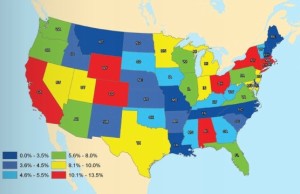A team of social scientists and economists from Colorado and California recently completed a study on the United States economy’s sensitivity to weather variability: extreme heat, extreme cold, droughts, and floods. This study marked the first time that US economic susceptibility to extreme weather had been explicitly quantified.
Seventy years of atmospheric data were used in conjunction with financial data from eleven nongovernmental sectors of the US economy: 1) agriculture, 2) communications, 3) construction, 4) manufacturing, 5) mining, 6) retail trade, 7) services, 8.) transportation, 9) utilities, 10) wholesale trade, and 11) finance, insurance, and real estate.
Mining was found to exhibit the greatest economic sensitivity to extreme weather, which makes sense given that oil, coal, and gas extraction is highly sensitive to price fluctuations from consumers due to weather variability. As expected, agriculture was also found to exhibit high economic sensitivity to extreme weather (second only to mining). However, since agriculture makes up less than 1.5% of the US gross domestic product (GDP), its absolute effect is relatively small.
Overall, variation in total precipitation (i.e. floods, droughts) had a larger effect on gross domestic product by state (GSP) than did temperature fluctuations. New York was found to be the most sensitive state, exhibiting an economic sensitivity of up to 13.5% of their GSP during extreme weather events over the course of the seventy years of this study. Tennessee was found to be the least sensitive, with a maximum 2.5% variability in GSP due to extreme weather. As seen in Figure 2, however, no part of the country generally appears to be more economically sensitive than any other part. The authors mention that this was slightly surprising; for example, one might expect coastal Atlantic states to show a slightly higher sensitivity given the recurring impact of tropical storms and hurricanes on those areas.

Figure 2: State economic sensitivity to extreme weather events as a percentage of total GSP. Image reproduced from Lazo et al.
As a whole, the US was shown to have an economic sensitivity of up to just 3.4% of their GDP, a much lower percentage than most of the states on their own. This illustrates the important fact that nationwide economic production can be adaptive in times of extreme weather and temporarily shift to different locales, thereby mitigating a sharp decrease in national production.
Still, of the US GDP ($14.4 trillion at 2008 dollar levels), this 3.4% still accounts for up to $485.2 billion of economic loss due to extreme weather events. The authors of this study suggest that some of the principle ways that some of this loss could be avoided is by investing in production methods such as better insulation of factory roofs, better drainage systems along key transportation routes, and more weather resistant crops.
The continued improvement of forecasting methods will also decrease the US economic sensitivity to extreme weather. However, they also point out that even with perfect forecasts, it is highly unlikely that all sensitivity can be mitigated. Regardless, with $485.2 billion in potential impacts at 2008 levels, the authors assert that it should be obvious this is still no small matter.
Reference
Lazo, J.K., M. Lawson, P. Larsen, and D. Waldman, 2011: U.S. Economic Sensitivity to Weather Variability. Bull. Amer. Meteor. Soc., 92, 709-720.


Comments are closed.